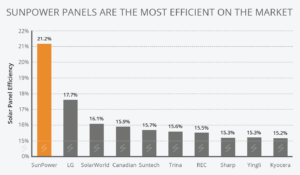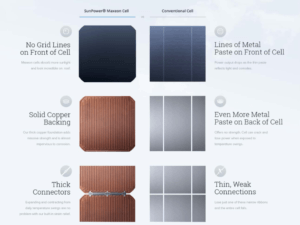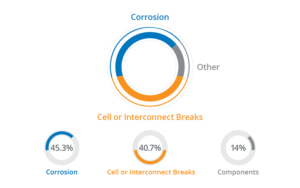While the word “degradation” may sound negative, it shouldn’t deter you from saving thousands of dollars over the lifetime of your home solar system. Instead, it’s important to understand what it means and how it can impact your savings. The performance of tech products you purchase, from cell phones to appliances, will degrade over time. Solar cell production is no different. The degradation rate can impact the amount of electricity your system produces over time, ultimately impacting your savings potential. The good news is that most solar modules will continue to generate at least 80% of their original solar power output after 25 years.
Before you add solar panels to your rooftop, you should have a good understanding of your system’s overall lifetime performance and how solar panel degradation can impact your electricity production and savings as well.
An overview of solar panel degradation
Over time there is a natural reduction of power output in solar panels. The rate at which this occurs is called the degradation rate. The average degradation rate for panels on the market is 0.5% each year. In terms of solar technology, losing a percentage can impact your overall maximum savings potential, so it’s an important factor to review before you sign your contract.
Most solar panel manufacturers don’t usually list their degradation rate on spec sheets, likely because the actual degradation rate will vary since it’s affected by other conditions and factors outside of their control. This is why looking at the manufacturer’s power warranty is important. Every solar panel manufacturer offers a warranty to guarantee your panels will produce a certain amount of electricity during the lifespan of the system. SunPower solar panels have the lowest degradation rates in the industry, with a guarantee that your panels won’t lose more than 8% of their original DC power output during their 25-year warranty coverage. This compares to a 17% power output for conventional solar panels.
How degradation impacts solar savings
Before installing solar panels, you should understand what your system’s performance will look like throughout its lifetime and how solar panel degradation can impact your overall energy output and savings. The larger your solar panel system is, the more electricity it will generate and the more you’ll save on electricity bills. But your solar savings will change slightly from year to year because of degradation, which is where the value of efficient panels with low degradation rates, like SunPower, can provide more benefits in the long run. Overall, while degradation does impact your solar savings, it’s not as much as you’d expect. It’s a small amount compared to the thousands of dollars you’ll save over the lifetime of your system.
If your electricity needs increase over time and your panels produce slightly less each year, you’ll have to pull more electricity from the grid, which could mean higher energy bills as time goes on. One way homeowners prepare for this uptick in energy usage is to install more solar panels than they initially need. This provides extra assurance that you’ll be able to meet your home’s future electricity needs. Additionally, you can pair a home battery with your solar panel system to offset your reliance on the grid. The battery will store the excess energy your home produces for future use, like overnight or during the winter months when there’s less sun, to save you even more over time.
Why some solar panels degrade faster than others
We know that all solar panels degrade over time, but why does it vary from one product or system to the next? Here are a couple reasons:
Solar Panel Technology
Every company builds solar panels with different materials and in different ways, which makes them more or less susceptible to degradation. While all solar panels generate energy from the sun using a semiconductor material (silicon), degradation differs based on the panel type as well as the semiconductor material used, the circuitry’s layout within the panel and the module’s overall composition.
Conventional solar cells are often recognizable and have visible metal grid lines on the front of the cell. While your roof heats up during the day, the metal expands and then contracts as it cools down. When it comes to solar panels, the process of continuous expansion and contraction can cause the solar cells to weaken and ultimately lose production over time. The solar cells in SunPower solar panels differ from conventional solar panels. The unique copper backing of each SunPower Maxeon solar cell provides the durability and strength needed to withstand corrosion and weathering. Plus, the front of the cell is unobstructed and has a light-trapping surface, which is the perfect formula for generating power and makes SunPower solar panels highly efficient.
Cell failures are minimal with SunPower.
Due to technology and design, conventional solar cells lose power over time. This is primarily due to poor connectivity, corrosion and breakage. But the unique design of SunPower solar cells eliminates 85% of the reasons conventional cells fail.
Climate
All solar panel manufacturers put their modules through a rigorous testing and certification process to ensure that they’ll continue to generate electricity for 25+ years. These tests include reviewing how panels perform in various climates and weather conditions like humidity, extreme cold and heat, UV light exposure and more. While solar panels are designed to withstand most conditions, panels that experience more extreme weather conditions usually degrade at an accelerated rate.
Conclusion
As we have seen, degradation is a factor to consider when evaluating the long-term cost and savings potential of solar panels. However, this is only one piece of the puzzle. Our certified solar representatives can answer all your questions regarding solar panel degradation, potential solar savings and more. If you’re ready to change the way you power your home and start saving more with solar, contact us today for a free customized quote.



